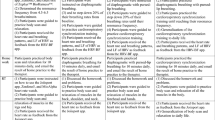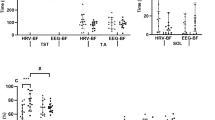Abstract
The present study was designed to examine the effect of heart rate variability (HRV) biofeedback on the cardiorespiratory resting function during sleep in daily life. Forty-five healthy young adults were randomly assigned to one of three groups: HRV biofeedback, Autogenic Training (AT), and no-treatment control. Participants in the HRV biofeedback were instructed to use a handheld HRV biofeedback device before their habitual bedtime, those in the AT were asked to listen to an audiotaped instruction before bedtime, and those in the control were asked to engage in their habitual activity before bedtime. Pulse wave signal during sleep at their own residences was measured continuously with a wristwatch-type transdermal photoelectric sensor for three time points. Baseline data were collected on the first night of measurements, followed by two successive nights for HRV biofeedback, AT, or control. Cardiorespiratory resting function was assessed quantitatively as the amplitude of high-frequency (HF) component of pulse rate variability, a surrogate measure of respiratory sinus arrhythmia. HF component increased during sleep in the HRV biofeedback group, although it remained unchanged in the AT and control groups. These results suggest that HRV biofeedback before sleep may improve cardiorespiratory resting function during sleep.

Similar content being viewed by others
References
Agnew, H. W., Jr., Webb, W. B., & Williams, R. L. (1966). The first night effect: An EEG study of sleep. Psychophysiology, 2, 263–266.
Ben-Tal, A., Shamailov, S. S., & Paton, J. F. (2012). Evaluating the physiological significance of respiratory sinus arrhythmia: Looking beyond ventilation–perfusion efficiency. Journal of Physiology, 590, 1989–2008.
Bonnet, M. H., & Arand, D. L. (1997). Heart rate variability: Sleep stage, time of night, and arousal influences. Electroencephalography and Clinical Neurophysiology, 102, 390–396.
Cowan, M. J., Pike, K. C., & Budzynski, H. K. (2001). Psychosocial nursing therapy following sudden cardiac arrest: Impact on two-year survival. Nursing Research, 50, 68–76.
Del Pozo, J. M., Gevirtz, R. N., Scher, B., & Guarneri, E. (2004). Biofeedback treatment increases heart rate variability in patients with known coronary artery disease. American Heart Journal, 147, G1–G6.
Dew, M. A., Hoch, C. C., Buysse, D. J., Monk, T. H., Begley, A. E., Houck, P. R., et al. (2003). Healthy older adults’ sleep predicts all-cause mortality at 4 to 19 years of follow-up. Psychosomatic Medicine, 65, 63–73.
Ebben, M. R., Kurbatov, V., & Pollak, C. P. (2009). Moderating laboratory adaptation with the use of a heart-rate variability biofeedback device (StressEraser). Applied Psychophysiology and Biofeedback, 34, 245–249.
Giardino, N. D., Glenny, R. W., Borson, S., & Chan, L. (2003). Respiratory sinus arrhythmia is associated with efficiency of pulmonary gas exchange in healthy humans. American Journal of Physiology, 284, H1585–H1591.
Greenhouse, S. W., & Geisser, S. (1959). On methods in the analysis of profile data. Psychometrika, 24, 95–112.
Hall, M., Vasko, R., Buysse, D., Ombao, H., Chen, Q., Cashmere, J. D., et al. (2004). Acute stress affects heart rate variability during sleep. Psychosomatic Medicine, 66, 56–62.
Hassett, A. L., Radvanski, D. C., Vaschillo, E. G., Vaschillo, B., Sigal, L. H., Karavidas, M. K., et al. (2007). A pilot study of the efficacy of heart rate variability (HRV) biofeedback in patients with fibromyalgia. Applied Psychophysiology and Biofeedback, 32, 1–10.
Hayano, J., Barros, A. K., Kamiya, A., Ohte, N., & Yasuma, F. (2005). Assessment of pulse rate variability by the method of pulse frequency demodulation. BioMedical Engineering OnLine, 4, 62.
Hayano, J., & Yasuma, F. (2003). Hypothesis: Respiratory sinus arrhythmia is an intrinsic resting function of cardiopulmonary system. Cardiovascular Research, 58, 1–9.
Hayano, J., Yasuma, F., Okada, A., Mukai, S., & Fujinami, T. (1996). Respiratory sinus arrhythmia-phenomenon improving pulmonary gas exchange and circulatory efficiency. Circulation, 94, 842–847.
Heilman, K. J., Handelman, M., Lewis, G., & Porges, S. W. (2008). Accuracy of the StressEraser in the detection of cardiac rhythms. Applied Psychophysiology and Biofeedback, 33, 83–89.
Karavidas, M. K., Lehrer, P. M., Vaschillo, E., Vaschillo, B., Marin, H., Buyske, S., et al. (2007). Preliminary results of an open label study of heart rate variability biofeedback for the treatment of major depression. Applied Psychophysiology and Biofeedback, 32, 19–30.
Kishimoto, Y., & Terasaki, S. (1986). Japanese edition of the State-Trait Anxiety Inventory (STAI). Research Bulletin of Faculty of General Education (Kinki University), 17, 1–14. (in Japanese).
Lehrer, P. M., Vaschillo, E., & Vaschillo, B. (2000). Resonant frequency biofeedback training to increase cardiac variability: Rationale and manual for training. Applied Psychophysiology and Biofeedback, 25, 177–191.
Lehrer, P. M., Vaschillo, E., Vaschillo, B., Lu, S. E., Eckberg, D. L., Edelberg, R., et al. (2003). Heart rate variability biofeedback increases baroreflex gain and peak expiratory flow. Psychosomatic Medicine, 65, 796–805.
Lehrer, P., Vaschillo, E., Vaschillo, B., Lu, S. E., Scardella, A., Siddique, M., et al. (2004). Biofeedback treatment for asthma. Chest, 126, 352–361.
Mallon, L., Broman, J. E., & Hetta, J. (2002). Sleep complaints predict coronary artery disease mortality in males: A 12-year follow-up study of a middle-aged Swedish population. Journal of Internal Medicine, 251, 207–216.
McCray, R., Atkinson, M., & Tomasino, D. (2003). Impact of a workplace stress reduction program on blood pressure and emotional health in hypertensive employees. Journal of Alternative and Complementary Medicine, 9, 355–369.
McLay, R. N., & Spira, J. L. (2009). Use of a portable biofeedback device to improve insomnia in a combat zone, a case report. Applied Psychophysiology and Biofeedback, 34, 319–321.
Nolan, R. P., Kamath, M. V., Floras, J. S., Stanley, J., Pang, C., Picton, P., et al. (2005). Heart rate variability biofeedback as a behavioral neurocardiac intervention to enhance vagal heart rate control. American Heart Journal, 149, 1137-e1–1137-e7.
Pagani, M., Lombardi, F., Guzzetti, S., Rimoldi, O., Furlan, R., Pizzinelli, P., et al. (1986). Power spectral analysis of heart rate and arterial pressure variabilities as a marker of sympatho-vagal interaction in man and conscious dog. Circulation Research, 59, 178–193.
Pomeranz, B., Macaulay, R. J., Caudill, M. A., Kutz, I., Adam, D., Gordon, D., et al. (1985). Assessment of autonomic function in humans by heart rate spectral analysis. American Journal of Physiology, 248, H151–H153.
Sakakibara, M., & Hayano, J. (1996). Effect of slowed respiration on cardiac parasympathetic response to threat. Psychosomatic Medicine, 58, 32–37.
Sakakibara, M., Kanematsu, T., Yasuma, F., & Hayano, J. (2008). Impact of real-world stress on cardiorespiratory resting function during sleep in daily life. Psychophysiology, 45, 667–670.
Sakakibara, M., Takeuchi, S., & Hayano, J. (1994). Effect of relaxation training on cardiac parasympathetic tone. Psychophysiology, 31, 223–228.
Sasaki, Y. (1976). Practice of Autogenic Training. Tokyo: Sogensha. (in Japanese).
Schultz, J. H., & Luthe, W. (1969). Autogenic methods. In W. Luthe (Ed.), Autogenic therapy (Vol. 1). New York: Grune & Stratton.
Spielberger, C. D., Gorsuch, R. L., & Lushene, R. E. (1970). Manual for the State-Trait Anxiety Inventory (self-evaluation questionnaire). Palo Alto, CA: Consulting Psychologists Press.
Toussaint, M., Luthringer, R., Schaltenbrand, N., Carelli, G., Lainey, E., Jacqmin, A., et al. (1995). First-night effect in normal subjects and psychiatric inpatients. Sleep, 18, 463–469.
Toussaint, M., Luthringer, R., Schaltenbrand, N., Nicolas, A., Jacqmin, A., Carelli, G., et al. (1997). Changes in EEG power density during sleep laboratory adaptation. Sleep, 20, 1201–1207.
Vaschillo, E., Vaschillo, B., Pandina, R. J., & Bates, M. E. (2011). Resonances in the cardiovascular system caused by rhythmical muscle tension. Psychophysiology, 48, 927–936.
Yucha, C. B., Tsai, P. S., Calderon, K. S., & Tian, L. (2005). Biofeedback-assisted relaxation training for essential hypertension: Who is most likely to benefit? The Journal of Cardiovascular Nursing, 20, 198–205.
Zucker, T. L., Samuelson, K. W., Muench, F., Greenberg, M. A., & Gevirtz, R. N. (2009). The effects of respiratory sinus arrhythmia biofeedback on heart rate variability and posttraumatic stress disorder symptoms: A pilot study. Applied Psychophysiology and Biofeedback, 34, 135–143.
Acknowledgments
This work was supported in part by a Grant-in-Aid for Scientific Researches No. 24653201, from the Japanese Ministry of Education, Culture, Sports, Science and Technology to M. Sakakibara. The authors are grateful to Tokai Gakuen University for support in conducting the study.
Author information
Authors and Affiliations
Corresponding author
Rights and permissions
About this article
Cite this article
Sakakibara, M., Hayano, J., Oikawa, L.O. et al. Heart Rate Variability Biofeedback Improves Cardiorespiratory Resting Function During Sleep. Appl Psychophysiol Biofeedback 38, 265–271 (2013). https://doi.org/10.1007/s10484-013-9232-7
Published:
Issue Date:
DOI: https://doi.org/10.1007/s10484-013-9232-7




